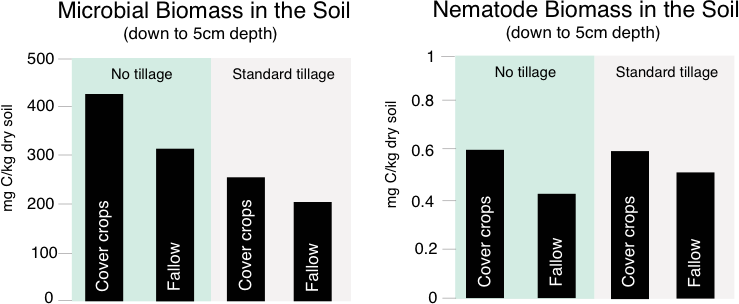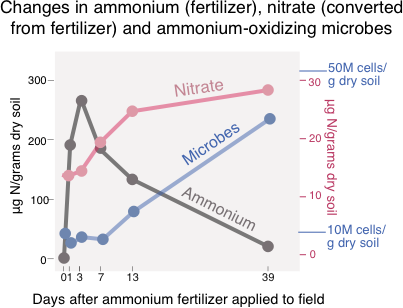We are exploring how different farm management methods affect the species of microbes and other living things in the soil (soil biodiversity)
Below-Ground Biodiversity in Context
- The soil is home to a complex ecosystem of animals, plants, and microbes (including bacteria, fungi and viruses)
- These below-ground organisms play major roles in the health of above-ground ecosystems
How we look at below-ground biodiversity
We track changes in the biomass and diversity of soil microbial and faunal communities over time. Key research questions we are exploring include:
- How does the long-term use of various soil management practices (over 20+ years) impact soil biodiversity?
- How does soil quality affect soil microbial populations and communities?
- How does soil biodiversity affect important soil qualities, like structure, nitrogen leaching, and greenhouse gas emissions?
- How do changes in soil communities affect the rates of decomposition, suppression of pathogens, and other soil functions?

Featured Research Projects
- Farm Management effects on soil diversity
-
Our research on the biodiversity of soil communities in farming systems has found divergence in the types of organisms present in the soils in:
organic vs. conventionally grown fields (with organic fields containing more microbes)
farmed versus unmanaged fields (with unmanaged fields containing more microbes)
We have also explored how specific techniques affect soil communities, such as:
growing crops continuously throughout the year (including winter cover crops) vs. leaving fields fallow in the winter
using no-till practices compared to standard tillage.Explore the results of some of our research in the diagram below, or read the paper.

Russell Ranch Research: How do tillage and cover cropping practices affect microbe and nematode numbers in the soil? Microbial biomass was higher under no-till, continuous cropping compared to standard tillage, fallow systems. Nematode populations were lowest in no-till, fallow systems, compared to the continuous cropping systems. Figure adapted from Minoshima et al. 2007.
- Soil microbial response to fertilizer application
-
 In 2004 researchers at developed a new qPCR method to track the populations of soil bacteria that play a role in converting ammonium (from fertilizer) into nitrate.
In 2004 researchers at developed a new qPCR method to track the populations of soil bacteria that play a role in converting ammonium (from fertilizer) into nitrate.We found that the ammonium-oxidizing microbial population quickly grew after fertilizer application, correlating with both the decline in ammonium and the increase in nitrate in the soil (see figure to the right).
To learn more about these results, read the paper.
- Farm management and foodborne illness
- coming soon